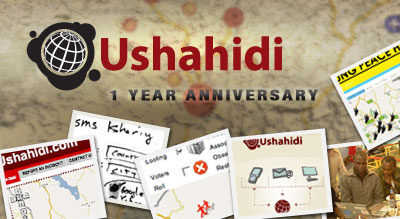
This week, Jan 9th, marks the one year anniversary of Ushahidi being deployed in Kenya. It's been a crazy, challenging and fulfilling year for all of us involved, and it's success is in no small part due to you and your belief in what we're doing and what Ushahidi represents.
Our goal is to decrease the impact of crisis. To democratize information, specifically in crisis and disaster situations. To create a platform, developed by an extended community, whose purpose is to create a new way to gather, visualize and disseminate distributed data. Where mobile phones are the common denominator and having access to the internet is a nice addition. Where control is federated and ordinary people have a voice. Making visible (and real) the crisis happening around the world, so that people can act on it.
Important historical benchmarks:
And things are just getting started. 2009 will be an even more eventful year, and we're going to need a lot of help to get all of it done.
Ushahidi is growing
We're bringing on our first full-time developer this week too.
Henry Addo is an amazing developer from Ghana. We initially met him as
TED Global Fellows in Arusha, Tanzania - well before the events that caused Ushahidi to be developed happened. As we get busier, we expect to bring on a couple more core developers to help manage the growth and maintain the code.
Okay, so what's next?
As we move forward into 2009, the goal is to grow the communities that support Ushahidi, and to become a sustainable non-profit software organization, modeling after others in this space such as
Mozilla and
Automattic. You will see us continue to embrace the changing nature of media and information - always focused on creating tools that make it easier for ordinary people to use what the devices they already have to tell their story to the world.
Major technology features and development areas
This isn't the full list for 2009, but it will give you a taste of the general direction we're going, and why, on both the mobile phone and internet/web side of things.
Mobile
Mobile phones are the one ubiquitous technology found all over the globe, and it is the only widespread device used in Africa. If the goal of Ushahidi is to let ordinary people submit reports and know of incidents happening around them, then we must ensure that any phone can be used for this purpose.
It’s also important to make this a two-way messaging system. Not only will people submit reports into Ushahidi, but they should also be able to receive alerts and updates of the incidents that are happening around them. An extension of this is to add functionality that allows groups in position to help people in their time of need can connect through this communication loop.
Mobile features, functionality and integration:
Web
Due to the continued blurring of the lines between web and mobile applications, the web focus leans towards supporting technologies that allow mobile transfer of data to the web and vice versa.
The broader goal for Ushahidi on the web is to
not replicate pre-existing open source software. Multiple extensions and modules, listed in detail below, are in the development time line to add functionality and save time and energy instead of trying to develop our own capacities in that same space. The Ushahidi API is a core piece of this puzzle, and extra attention is given to it in the overall development of the platform.
Web features, functionality and integration:
- API v2
- Laconica (an open source Twitter clone)
- Better news clustering and feed customization
- Custom map tile solution
- Better 3rd party API integration for Twitter and Flickr
- Open translation process v1
- Huridocs integration
- InSTEDD's Mesh4x
- Wiki tools and integration
Final thoughts
2008 was a very (very) busy year, but we believe 2009 will be even better and more active. We're hoping that more join in, pushing Ushahidi to greater heights and more usage around the world.
Thank you for being part of the team, and for making Ushahidi what it is today.
(special thanks to
Caleb Bell for the graphic)
